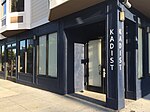Neuralink

Neuralink Corporation is a neurotechnology company that develops implantable brain–machine interfaces (BMIs). Co-founded by Elon Musk, the company's headquarters is in the Pioneer Building in San Francisco sharing offices with OpenAI. Neuralink was launched in 2016 and was first publicly reported in March 2017.Since its founding, the company has hired several high-profile neuroscientists from various universities. By July 2019, it had received $158 million in funding (of which $100 million was from Musk) and was employing a staff of 90 employees. At that time, Neuralink announced that it was working on a "sewing machine-like" device capable of implanting very thin (4 to 6 μm in width) threads into the brain, and demonstrated a system that read information from a lab rat via 1,500 electrodes. They had anticipated starting experiments with humans in 2020; but have since moved that projection to 2022.Several neuroscientists and publications, including the MIT Technology Review, have criticized claims made by Musk in relation to the technology.
Excerpt from the Wikipedia article Neuralink (License: CC BY-SA 3.0, Authors, Images).Neuralink
18th Street, San Francisco
Geographical coordinates (GPS) Address Nearby Places Show on map
Geographical coordinates (GPS)
| Latitude | Longitude |
|---|---|
| N 37.7623 ° | E -122.4148 ° |
Address
Pioneer Building
18th Street 3180
94110 San Francisco
California, United States
Open on Google Maps







